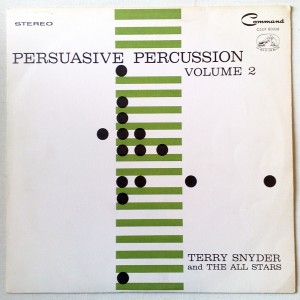Pye Records Command, 1960. PCLS 808
This has to be my favourite ever charity shop purchase. I used to hope for some rare gem which might complement music I already have, but the real joy of charity shops is the completely insane music they’re often full of, and which, unless you’re in Oxfam, are rarely more than a quid.
In one of my rants on this blog I moan about MP3s and the curse of music for people who don’t like music. This is also music for people who don’t like music, but from a different and less cynical era. The sleeve notes give the game away. There’s nothing there at all about the music or the musicians, just a marketing blurb about how great it sounds and absurd technical data no-one could ever possibly want to know or even understand. We’re even told the manufacturer and model number of the lathe used to cut the master disc! This record was made in the early days of hi-fi, when an expensive stereo was essential for the upwardly mobile business executive to display alongside his G-Plan furniture, swirly orange carpets, nylon shirts and trophy wife. The problem for said executive was that he needed something to play on his absurdly expensive gear, but knew as much about music as the average X-Factor viewer does today. That lead very quickly to a lucrative market in music aimed at the clueless middle classes, of which this is a very good example.
It needed to have several features to work in this market. The cover was really important; the front had to look good with contemporary interior decor, and the sleevenotes had to flatter the buyer’s knowledge of hi-fi. It also had to sound good – and often they really did. This album is one of the best sounding LPs I’ve ever heard which is amazing when you consider that it’s over 50 years old and isn’t in pristine condition. It had to have as many wacky stereo effects as possible – stereo was very new back then, and it was necessary to be able to show off to the neighbours when you’d spent the money on something so exotic. Finally it had to sound sophisticated. This meant jazz, or at least a dumbed down kitsch version of it with instrumental pyrotechnics, but remaining at all times conservative and undemanding.
So why might you want to listen to this music, cynically produced and marketed for a particularly nauseating section of the population? Well partly because it is an amazing period piece – it takes you right back to 1960 more powerfully than anything else I can think of. What it lacked in authenticity at the time it now has in spades as a cultural artefact from 1960. But it’s also worth listening to because despite all the hideous marketing that went on to shift this record, the actual business of making the music was left to, well, musicians. So underneath all the kitsch, a lot of this stuff is actually pretty inventive and very groovy. This is what sets it apart from X Factor – on that show and many like it, the marketing guys control the music, but here, while the musicians have to work within parameters set by the marketing guys, they were left to their own devices, so if you like music, there’s something for you here.
